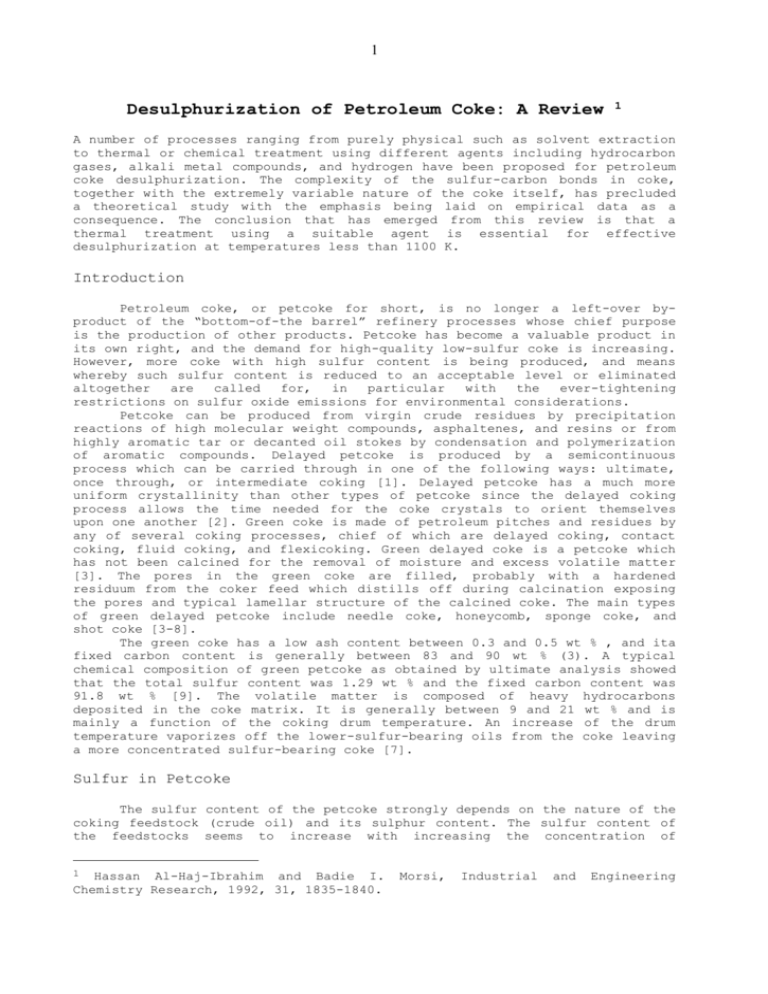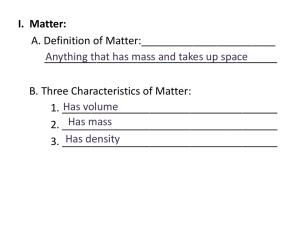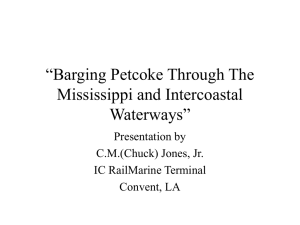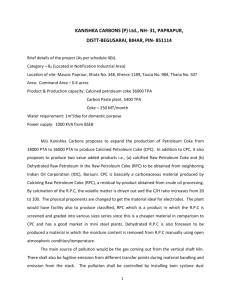Desulphurization of Petroleum Coke: A Review
advertisement

1 Desulphurization of Petroleum Coke: A Review 1 A number of processes ranging from purely physical such as solvent extraction to thermal or chemical treatment using different agents including hydrocarbon gases, alkali metal compounds, and hydrogen have been proposed for petroleum coke desulphurization. The complexity of the sulfur-carbon bonds in coke, together with the extremely variable nature of the coke itself, has precluded a theoretical study with the emphasis being laid on empirical data as a consequence. The conclusion that has emerged from this review is that a thermal treatment using a suitable agent is essential for effective desulphurization at temperatures less than 1100 K. Introduction Petroleum coke, or petcoke for short, is no longer a left-over byproduct of the “bottom-of-the barrel” refinery processes whose chief purpose is the production of other products. Petcoke has become a valuable product in its own right, and the demand for high-quality low-sulfur coke is increasing. However, more coke with high sulfur content is being produced, and means whereby such sulfur content is reduced to an acceptable level or eliminated altogether are called for, in particular with the ever-tightening restrictions on sulfur oxide emissions for environmental considerations. Petcoke can be produced from virgin crude residues by precipitation reactions of high molecular weight compounds, asphaltenes, and resins or from highly aromatic tar or decanted oil stokes by condensation and polymerization of aromatic compounds. Delayed petcoke is produced by a semicontinuous process which can be carried through in one of the following ways: ultimate, once through, or intermediate coking [1]. Delayed petcoke has a much more uniform crystallinity than other types of petcoke since the delayed coking process allows the time needed for the coke crystals to orient themselves upon one another [2]. Green coke is made of petroleum pitches and residues by any of several coking processes, chief of which are delayed coking, contact coking, fluid coking, and flexicoking. Green delayed coke is a petcoke which has not been calcined for the removal of moisture and excess volatile matter [3]. The pores in the green coke are filled, probably with a hardened residuum from the coker feed which distills off during calcination exposing the pores and typical lamellar structure of the calcined coke. The main types of green delayed petcoke include needle coke, honeycomb, sponge coke, and shot coke [3-8]. The green coke has a low ash content between 0.3 and 0.5 wt % , and ita fixed carbon content is generally between 83 and 90 wt % (3). A typical chemical composition of green petcoke as obtained by ultimate analysis showed that the total sulfur content was 1.29 wt % and the fixed carbon content was 91.8 wt % [9]. The volatile matter is composed of heavy hydrocarbons deposited in the coke matrix. It is generally between 9 and 21 wt % and is mainly a function of the coking drum temperature. An increase of the drum temperature vaporizes off the lower-sulfur-bearing oils from the coke leaving a more concentrated sulfur-bearing coke [7]. Sulfur in Petcoke The sulfur content of the petcoke strongly depends on the nature of the coking feedstock (crude oil) and its sulphur content. The sulfur content of the feedstocks seems to increase with increasing the concentration of 1 Hassan Al-Haj-Ibrahim and Badie I. Chemistry Research, 1992, 31, 1835-1840. Morsi, Industrial and Engineering 2 asphaltenes and Conradson carbon content. For instance, higher sulphur contents were found in “sponge” coke (produced from high-resin asphaltene feedstocks) than in “honeycomb” coke (produced from low-resin asphaltene feedstocks) or “needle” coke (produced from highly-aromatic feedstocks). The sulfur content in petcoke varies widely (from less than 0.5% in gilsonite to more than 10%) mainly depending on the sulfur content of feedstock [10]. Typically, sponge coke contains between 1 % and 6%. Sponge coke containing 4% is used for fuel whereas that of less than 4% sulfur content is used in anode manufacturing. Needle cokes for electrode manufacturing are required to have lese than 1% sulfur content [11]. Sulfur contents in sponge cokes have been correlated to the sulfur content and Conradson carbon residue of feedstock by Jacob (7). He found that the sulfur content of sponge coke increases almost proportionally to the feedstock sulfur contents and increases less strongly with increasing Conradson carbon residue. Coking temperature also affects the sulfur content of petcoke, though in less degree, mainly due to the vaporization and removal of the low sulfur containing volatile matter which result in a reduction of the total sulphur content in the coke [7]. Most of the sulfur in petcoke exists as organic sulphur bound to the carbon matrix of the coke [12]. Some sulphur could also exist as sulfates and as pyritic sulfur [13] but these do not in general make up more than 0.02% of the total sulfur in coke (3). In at least one case, however, pyritic sulfur was reported to be as high as 0.4% (14). Free sulfur may occasionally be present [1]. The structure of organic sulfur compounds in petcoke remains largely unknown, and no precise analytical methods exist today to determine exactly this structure [3, 15]. The organic sulfur compounds identified by the Bureau of Mines in four crude oils include thiols (alkyl, cyclic, and aromatic), sulfides (alkyl, cyclic, and alkylcycloalkyl), disulfides (alkyl, cyclic, and aromatic), and thiophenes [16]. The thiophenes are most prevalent in the heavy fractions of crude oils and hence in coke. Other sulfur compounds are less prevalent in coke. Work done by Sabott [17] indicates that sulfur may not be present in coke in the form of thiols or aromatic and aliphatic sulfides, and sulfides do not make in fact more than 0.003% of the total sulfur in petcoke [3]. Sulfur may exist in the coke in many forms [3}: (a) as thiophenes attached to the aromatic carbon skeleton; (b) attached to side chains of aromatic or naphthenic molecules; (c) between the aromatic sheets or on the surface of clustered molecules; (d) on the coke surface or in coke pores bound by capillary condensation, adsorption, or chemisorption. Desulphurization of petcoke The desulphurization of petcoke involves the desorption of the sulfur present in the coke pores or on the coke surface, and the partition and removal of the sulfur attached to the aromatic carbon skeleton. For the removal of sulfur in the first category a purely thermal treatment at temperatures less than 1100 K is generally sufficient. A more sever treatment and/or the use of chemicals is, however, necessary for the removal of the sulfur attached to the carbon skeleton, particularly in the case of the thiophenic sulfur which is much more stable than the other organic sulfur compounds and therefore much more difficult to remove. This makes it evident why the effective desulphurization of petcoke, involving as it does the rupture of the thiophenes, is not as simple a process as may be desired. The thiophenes do make up most of the sulfur present in the petcoke. They, on the other hand, are much less stable chemically than their aromatic isologs, and it is always possible to find compounds that react more readily with the thiophenes than with the aromatic or other compounds of the coke structure [18], a fact which can be made use of in desulphurization processes. 3 Processes for petcoke desulphurization Although much experimental work has been done on the desulphurization of petcoke, there is still as yet no commercial process for desulphurization [19]. One common feature of all, or most, published work is its exclusively empirical nature. This is presumably because a theoretical, thermodynamic and kinetic, study is not possible due to lack of essential data on the nature of S-C bonds, their free energy change (ΔG), and the manner and speed of sulfur replacement. In addition, some important factors such as the coke structure and porosity undergo significant changes during the course of desulphurization, a fact which makes the problem even more complicated [20]. 1. Solvent extraction. Solvent extraction would offer the simplest approach to desulphurization if it were possible to selectively dissolve the organic sulphur compounds present in the coke. As materials of similar chemical structure are more likely to be mutually soluble in one another, aromatic and similar compounds might be used as solvents. Experience with coal indicates that weak organic acids such as phenols and nitrobenzene are more effective than other organic solvents [16]. These could be used to dissolve sulfides and disulfides and possibly some thiophenes as well. Extractions with coke using a large variety of solvents were made in a Soxhlet extractor. No sulphur removal was reported when petroleum ether [21], dioxane [21] or hydrochloric acid [17, 21] were used. Extractions made with other solvents led to some sulphur removal, but in no case was more than 20% sulphur removed (Table 1). This indicates clearly that solvent extraction is not an effective method of desulphurization. However, the selectivity of solvent extraction would be enhanced if the coke macromolecule could be cleaved. Coke depolymerization can be effected by different methods including mild hydrogenation, oxidation and pre-pyrolysis. The effectiveness of these depolymerization techniques has not been investigated. Phillips and Chao [14] found that increasing the extraction temperature improved desulphurization from 11% at 290 K to 20% at 430 K. This can be explained by the fact that some coke depolymerization must have taken place as a result of the extraction temperature increase. 2. Thermal desulphurization. By thermal desulphurization is meant the process whereby a fixed static bed of petcoke is heated under atmospheric pressure in an inert atmosphere to a specified temperature and then kept at that temperature for a specified period of time. This process was felt to be the most promising process for the desulphurization of petcoke, and can be the only one possible when other techniques prove to be difficult or inefficient as was found in at least one case with Syrian petcoke [12]. Further, petcokes are normally calcined up to a temperature of about 1700 K and desulphurization could be an added asset if it can be shown to take place to a significant degree within this temperature range. The efficiency of desulphurization, however, is not only dependent on the maximum temperature to which the coke is subjected, but other factors affect it also including rate of heating, gas atmosphere and in particular residence time at the maximum temperature. In order to neutralize the effect of this last factor, a constant value of 30 min residence time was assigned to it throughout and a comparison of the effects of temperature were made on this basis. Table 2 gives a summary of the maximum desulphurization achieved under these conditions at different maximum temperatures. An examination of this table makes it evident that the process of thermal desulphurization can be divided into four stages: (a) The first is an initial phase of desulphurization (300-1100 K), with the desorption of sulphur bound on the surface or in the pores, and the simultaneous cracking of side chains of aromatic molecules. The sulphur bound on the surface refers to the S-C bonds in the outer layers of clusters (pre 4 walls, surfaces) that can be physically exposed to the fluid environments. The process of sulfur separation starts at 770-820 K, first increasing to reach a maximum at about 1000 K and then decreasing until it stops at 1270 K [22]. The maximum amount of sulphur removed in this stage is about 25% (Table 2), which can be taken as a rough indication of the amount of non-thiophenic sulphur in coke. Experimental work indicates that no reaction occurs during this stage between metal contaminants and sulphur gases, since no variation in the degree of desulphurization of different cokes with different amounts of metals was observed [22]. (b) A second stage is that in which little or no desulphurization takes place (1100-1600 K), particularly in the case of coke made from aromatic-type feedstock. Most of the sulphur removed is derived from the decomposition of the thermally-stable sulphur hydrocarbons bound in side chains. Ash and Metal contaminants seem to have no effect on desulphurization up to a temperature of 1500 K [22, 24, 25]. The inhibiting effect of ash would be related to its amount and composition [26]. Metal-hydrocarbon compounds refer mainly to vanadium and nickel metals that are trapped in the porphyrinic structures. These metals, certainly, survive coking temperatures [23]. It should be also mentioned that the metals in the feedstock end up in the coke structure. At temperatures greater than or equal to 1500 K desulphurization is significantly depressed by the metalhydrocarbon compounds which react with the dissociated sulphur to form refractory, thermally-stable metal sulphur compounds and sulfides [13, 16, 22, 24]. (c) Desulphurization is dramatically increased when coke is heated above 1600 K. The energy available at 1700 K is sufficiently high for the decomposition of sulphur-hydrocarbon compounds of stabilities up to those of thiophene structure [22]. Complete elimination of sulphur is not, however, likely even at this high temperature [25, 27]. The removal of sulphur is connected with the creation of an organized phase detectable by X-ray methods [20]. An organized phase refers to extended two-dimensional and very short tridimensional arrangements of aromatic layers that resemble graphitic structures which are typical characteristics of needle cokes. (d) Further increase in temperature (> 1800 K) is not certain to lead to more desulphurization, but this depends also on the nature of the coke. The degree of desulphurization is directly related to the total sulphur content of the coke. Gimaev and Syunyaev [28], on the other hand, found that for a particular type of coke the degree of desulphurization is affected only by the temperature and is independent of the initial amount of sulphur. The high temperature required for thermal desulphurization can affect some critical coke properties [21] and its effect is much more than the effect of residence time [29]. The apparent density increases from 1.2-1.4 to 1.6-2.0 g/cm3 on heating to 1600 K [15]. Above 1600 K density changes depend on the initial sulphur content, decreasing with cokes of high sulphur content and increasing with cokes of low sulphur content. Real density increases with temperature up to 1700 K, and then decreases [3, 5, 30]. The decrease of real density above 1700 K called “puffing” is a consequence of the porosity developed when the sulphur gets out of the coke matrix at temperatures above 1700 K. In applications above these temperatures, such as arc electric furnaces, this puffing effect can reach levels at which large pores are opened, and stresses are concentrated leading to breakage of graphitic electrodes. For this reason a dynamic puffing test is specified as a part of the characterization of filler cokes for these applications. The use of puffing inhibitors, such as Fe2O3, generally at 2 ppm level can reduce the puffing effect to an acceptable level [23]. Coke porosity increases with temperature and so does its reactivity [31]. The surface area increases to a maximum at about 1000 K and then decreases to a minimum at about 1300 K, beyond which there is a further increase in surface area [30]. Reis [3] found that the electric resistivity 5 of petcoke was reduced with increasing temperature up to 1600 K, but higher temperatures increase the electric resistivity which reaches a maximum at 2300 K [3]. Most desulphurization seems to occur within the first 30 minutes of the thermal treatment up to 1700 K. According to Akhmetov and Syunyaev [32] the highest rate of desulphurization is within the first 5 minutes, but this does not seem to apply in all cases as can be shown by the results of Brandt and Kapner [19]. Increasing the residence time has no effect on the degree of desulphurization except in the range 1600-1800 k [13, 19, 22, 25, 27]. It is not clear whether the elimination of sulphur is affected in any way by the inert gas used during the thermal treatment [33]. Most workers used nitrogen or argon. Carbon-nitrogen complexes are not likely to be formed when petcoke is heated in nitrogen [12]. The use of argon may inhibit desulphurization at lower temperatures, but more work is needed for more conclusive results. Thermal desulphurization under vacuum does not seem to be beneficial to desulphurization [20]. Decreasing the mean diameter of coke particles may improve the desulphurization efficiency [1, 32, 34], but there is no consensus on this point [13]. The use of a fluidized bed may improve the desulphurization efficiency [34]. 3. Oxidative desulphurization. The use of an oxidizing gas during the thermal treatment of petcoke may favor the removal of sulphur. This is related to the resulting weight loss of the coke and its improved porosity. Heating in CO2 inhibits desulphurization. In the experiments carried out by Hussein et. Al. [12] little desulphurization was observed below 1500 K (12%), but desulphurization was rapid at greater temperatures (67% at 1800 K). This was accompanied by lower coke yield. When petcoke was heated in oxygen, no sulphur was removed below a certain temperature (1000 k [33] or 1600 K [34]). Air can be used as an oxidizing gas. When coal was heated to 450˚C in air, a maximum of 20% of the organic sulphur was removed [16]. No tests with coke are reported. Petcoke can be desulfurized by heating under steam. In the temperature range of 9001300 K a maximum desulphurization of 31% was obtained [35, 36] and similar results were reported for coal [6]. More sulphur can be removed by raising the temperature to 1600-1800 K. This value reported for petcoke [35, 36] appears to be extremely high when compared with the desulphurization data using oxygen [34]. The use of a mixture of air and steam seemed to inhibit desulphurization [35]. Oxidizing agents might be used to oxidize thiols, sulfides, and disulfides to sulfonic acids which can be hydrolyzed in boiling water to eliminate H2SO4. Nitric acid was used for this purpose by Phillips and Chao [14] and Syunyaev et. al. [37], and a maximum desulphurization of 31% was achieved [14]. This was accompanied by an increase in oxygen and nitrogen and a decrease in carbon content [37]. 4. Desulphurization in an atmosphere of sulfur-bearing gas. Exposing the coke to H2S in the temperature range 1000-1200 K increases the sulphur content of the coke. H2S reacts with the incandescent carbon to form more stable carbonsulfur compounds [19, 35, 38, 39]. At elevated temperatures, however, sulphur-bearing gases decompose to form free sulphur or react to form free sulphur and thus induce desulphurization, with the preservation of the critical coke properties. Eighty-four percent sulphur removal was obtained by Brandt and Kapner at 1600 k [19]. 5. Treatment in hydrocarbon gases. Most laboratory work indicates that the removal of sulphur can be induced at elevated temperatures by fluidizing the hot petcoke with low molecular weight hydrocarbon gases. These decompose to liberate hydrogen, which assists desulphurization, while the carbon is deposited in the coke pores increasing thereby the coke density [19, 40]. Table 3 gives a summary of maximum desulphurization obtained when different hydrocarbon gases were used. 6 6. Treatment with alkali metal compounds. Coke may be desulfurized by treatment with an alhali metal compound. More than 98% sulphur can be removed using NaOH [38, 41, 42]. Other compounds may also be used with varying degrees of success [41, 42]. Different techniques were suggested in order to improve the desulphurization efficiency including preactivating the coke by fluidizing with air [43] or steam [44] or exposing the coke sample to microwave radiation [44]. A major disadvantage of this process is the consumption of large amounts of alkali compounds [38]. The presence of the alkali metal compounds in the treated coke is also indicated. 7. Hydrodesulphurization (HDS). Hydrodesulphurization is a common process of desulphurization in the oil industry, but it has not yet found application in the treatment of petcoke. The hydrodesulphurization reaction involves a number of steps. For the initial reaction, the diffusion of hydrogen into the pores of the granules appears to be the rate controlling step. As the reaction progresses, the rate-controlling step shifts to the reaction of hydrogen with sulphur compounds [46]. At 900 k it may be inferred that the chemical surface reaction and not the physical process is rate controlling [35]. At higher temperatures (> 1000 K) the reaction of H 2S with coke particles occurs more rapidly leading to the formation of new stable C-S compounds (the reverse reaction). In simple HDS petcoke is heated in a fixed bed under an atmosphere of hydrogen. Experimental work indicates that the rate of sulphur removal is greatest at about 1000 K, where about 50% of the sulphur is removed, but higher temperatures (1600 K) are required for the removal of the more refractory sulphur. At temperatures above 1300 K and below 1500 K sulphur removal is not apparent [20]. The maximum desulphurization at the optimum temperature can be explained by the fact that the net rate of desulphurization is the result of two competing processes, namely the removal of the labile sulphur by hydrogen and the thermal fixation of the sulphur by the reverse reaction which produces a more stable form of sulphur. The reverse reaction becomes more rapid at temperatures in the range 1000-1200 K. At elevated temperatures (1500-1800 K) the presence of H2S would induce sulphur removal, a fact which helps to explain the degree of desulphurization obtainable at 1600 K (92%). The efficiency of HDS may be improved by increasing the hydrogen flow rate to an optimum value [39] or by increasing the pressure. The use of fluidized bed desulphurization leads to greater desulphurization at reduced flow rates. This is probably due to the more efficient contact between hydrogen and coke [21]. Cooling the coke at different intervals during HDS improved the level of desulphurization, but this was effective only at certain critical temperatures (1000 K) [47, 48]. Similarly the effect of heating the coke in an inert atmosphere prior to introducing the hydrogen depended largely on the temperature at which the hydrogen was introduced, with the optimum temperature at about 720 K [49]. When the coke is heated in an inert atmosphere, cooled, and then heated in hydrogen, the level of desulphurization is either decreased [33] or greatly enhanced [50] in comparison with simple HDS depending on the pre-treatment temperature. Preoxidizing the coke at moderate temperatures may render it more amenable to HDS [51], but the advantage of this treatment is offset by the increased weight loss. The optimum temperature for maximum desulphurization and minimum weight loss was found to be in the range 570-620 K [48, 51-53]. The presence of steam in HDS can have variable effects depending on the temperature and/or steam flow rate [33, 42, 45]. Impregnating the coke with an aqueous solution of NaOH prior to HDS enhances desulphurization [54]. Miyoshi et. al. found that alkali desulphurization proceeded smoothly under hydrogen when the coke was exposed to microwave radiation [45]. 7 Conclusions Table 4 gives a summary of the most effective desulfurization processes (with sulphur removal greater than 84%). These are grouped into four classes according to the maximum temperature required for effective desulfurization. At temperatures >1700 K, effective desulfurization can be achieved by purely thermal treatment. Steam, sulphur-bearing gases or effluent gas recirculation can also be used, but with little advantage. In the temperature range 1400-1600 K, effective desulfurization can be achieved by simple HDS or on treatment with unsaturated hydrocarbon gases. In the temperature range 1170-1200 K, effective desulfurization can be achieved either by treatment with some alkali metal compounds (Na2CO3, K2CO3) or by preoxidation and subsequent treatment with methane. At temperatures lower than 1100 K, two processes are possible: (a) HDS using high pressures, NaOH impregnation, preoxidation or fluidization; (b) Treatment with NaOH or KOH. Given the fact that the consumption of great amount of alkali metal compounds is required for effective desulfurization and that preoxidation reduces the coke yield, it becomes evident that HDS in a fluidized bed offers the most attractive desulfurization process. This process is expected to be more effective with cokes of high sulphur content and high ash and heavy metals content, as at temperatures less than 1100 K the adverse effects of high ash and heavy metals content on desulfurization is largely avoided. The process would result in an increased porosity and surface area and improved reactivity. These properties are dependent on the sulphur concentration. The greater the amount of sulphur removed, the greater the structural changes expected in the coke treated. The coke density is expected to increase as a result of the treatment, and there will be some weight loss (<10%). References [1] [2] [3] [4] [5] [6] [7] [8] [9] [10] [11] [12] [13] Kobe and McKetta (eds); Advances in petroleum chemistry and refining, Interscience Publishers, New York, 1959, vol. 2. Deviney and O’Grady (eds); Petroleum derived carbons, Am. Chem. Soc., Washington, 1976. T. Reis; To coke, desulfurize and calcine, Part 2: Coke quality and its control, Hydrocarbon Processing, June 1975, pp. 97–104. R. A. Meyers, Handbook of petroleum refinery processes, McGraw-Hill Book Co., New York, 1986. Figueiredo and Mouljin (ed.); Carbon and coal gasification, Martinues Nijhoff Publishers, Dordrecht, 1986. NPRA Q&A Session on refining and petrochemical technology, The Petroleum Publishing Co., Tulsa, Oklahoma, 1976. R. J. Jakob; Coke quality and how to make it, Hydrocarbon Processing, Sept. 1971, vol. 50, No. 9, pp. 132 – 136. H. March, C. Calvert and J. Bacha; Structure and formation of shot coke, A microscopic study, J. Mat. Sci., 1985, 20, pp. 289 – 302. H. W. Nelson; Petroleum coke handling problems, Ind. Eng. Chem, Res.Dev., vol. 9, No. 2, pp. 176 – 178. Petroleum coke: Process economics program, Report No. 72-a, Stanford Research Institute, Menlo Park, CA, Oct. 1976. H. M. Feintuch; J. A. Bonilla; R. L. Godino; Delayed coking process, Handbook of petroleum refinery processes, R. A. Meyers ed., McGraw-Hill Book Co., New York, 1986, Ch. 7, pp. 43-49. M. K. Hussein, S. Z. El-tawil and M. A. Rabah; Desulphurization of high-sulfur Egyptian petroleum coke, J. Inst. Fuel, Sept. 1976, pp. 139 – 143. N. El-kaddah and S. Y. Ezz; Thermal desulphurization of ultra high sulphur petroleum coke, Fuel, 1973, vol. 52, pp. 128 – 129. 8 [14] [15] [16] [17] [18] [19] [20] [21] [22] [23] [24] [25] [26] [27] [28] [29] [30] [31] [32] [33] [34] [35] [36] [37] C. R. Phillips and K. S. Chao; Desulphurization of Athabasca petroleum coke by (a) chem. oxidation and (b) solvent extraction, Fuel, 1977, vol. 56, pp. 70 – 72. T. Reis; About coke and where the sulfur went, Chemtech, vol. 7, June 1977, pp.366 – 373. R. A. Meyers; Coal desulphurization, Marcel Dekker, New York, 1977. F. K. Sabott; A study of methods of removing sulfur from petroleum coke, Quarterly of the Colorado school of mines, vol. 47, No. 3, July 1952, pp. 1 – 22. H. D. Hartough; Thiophene and its derivatives, Intescience Publishers, New York, 1952. H. H. Brandt and R. S. Kapner; desulphurization of petroleum coke, Light Metals, 1984, pp. 883 – 887. J. Gillot, B. Lux, P. Cornuault and F. Du Chaffaut; Changement de structure lors de la desulfuration de coke de petrole, Carbon, vol. 6, pp. 389 – 395. B. H. Mahmoud, S. Ayad and S. Y. Ezz; Desulphurization of petroleum coke, Fuel, 1968, vol. 47 (6), pp. 455 – 462. Z. Vrbanovic; Thermal desulfurization of petroleum coke, High TempsHigh Pressures, 1981, vol. 13, pp. 167 – 176. J. Rodriguez; Needle coke production from Venezuelan oil residues, M.Sc. thesis, University of Pittsburgh, 1989. Z. Vrbanovic; Possibility of using high temperature treatment of petroleum coke to desulphurize it, Nafta (Zagreb), 1978, 29 (2), pp. 80 – 93. Z. Vrbanovic; Thermal desulfurization of petroleum coke, High TempsHigh Pressures, 1983, vol. 15, pp. 107 – 112. Z. I. Syunyaev and Y. M. Abyzgildin; Effect of ash components on petroleum coke desulphurization, Khim. Seraorg Soedin, Soderzh Neftyakh. Nefteprod, 1972, 9, pp. 440 – 444. Z. Vrbanovic; Thermal desulphurization of petroleum coke, Bienn. Conf. Carbon, 16th, 1981, pp. 190 –191. R. H. Gimaev and Z. I. Syunyaev; Effect of temperature on the equilibrium sulfur content of petroleum coke, Khim Seraorg Soefin, Soderzh Neft Nefteprod, 1972, 9, pp. 441 – 451. K. Skoczkowski; Effect of temperature and calcination time on the quality of anthracite and petroleum coke, Koks, Smola, Gaz, 1990, 35 (4), pp. 97 – 99. E. Barrillon; Evolution thermique de la texture poreuse des cokes de petrole, Carbon, 1967, 5, pp. 167 – 171. E. Barrillon; Modifications de la texture de cokes de petrole lors d’une desulfuration thermique, J. chim. phys. physiochim. biol., vol. 65, 1968, pp. 428- 432. M. M. Akhmetov and Z. I. Syunyaev; Thermal desulphurization of petroleum cokes, Neftekpererab Neftekhim, 1969, 4, pp. 9 – 12. W. C. Shafer; Removal of sulfur from petroleum coke by pyrolysis, Quarterly of the Colorado school of mines, vol. 47, No. 3, July 1952, pp. 27 – 37. S. Z. El-tawil and B. M. Morsi; Thermal treatment of Egyptian petroleum coke in an atmosphere of oxygen, J. Mines, Met. Fuels, 1979, 27 (6), pp. 185 – 191. B. S. Parmar and E. L. Tollefson; Desulphurization of oil sands coke, Can. J. of chem. Eng., 1977, vol. 55, pp. 185 – 191. N. Medovikova, S. V. Kaftanov, S. D. Fedoseev, N. N. Rusinovskaya and G. N. Razina; desulphurization of petroleum coke in superheated water vapour and preparation of water gas, Tr. Mosk. Khim.-Tekhnol. Inst., 1970, 66, pp. 7 – 10. Z. I. Syunyaev, R. N. Gimaev, Y. M. Abyzgildin, G. P. Malyatova and S. G. Zaitseva; Reactions of organosulfur compounds in petroleum coke, 9 [38] [39] [40] [41] [42] [43] [44] [45] [46] [47] [48] [49] [50] [51] [52] [53] [54] [55] [56] [57] [58] Khim Seraorg. Soedin, Soderzh Neftyakh Nefteprod., 1968, 8, pp. 381 – 386. Z. M. George, L. CG. Schneider and E. L. Tollefson; Desulphurization of a fluid coke similar to the Athabasca oil sands coke, Fuel, 1978, vol. 57, pp. 497 – 501. Z. M. George; Hydrodesulphurization of coke from Athabasca tar sands operation, Ind. Eng. Chem., Prod. Res. Dev., 1975, vol. 14, pp. 298 – 303. A. F. Al-ansary and S. Y. Ezz; desulphurization of petroleum coke by butagas, Fuel, 1973, vol. 52, pp. 66 –70. Z. M. George, B. S. Parmar and E. L. Tollefson; Desulphurization of high sulphur cokes from processing of oil sands bitumen, 2 nd Pacific Chem. Eng. Congress (Paches. 77), Denver, Colorado, 1977, vol. 2, pp. 1299 - 1305. S. J. Lukasiewicz and G. C. Johnson; Desulfurization of petroleum coke, Ind. Eng. Chem., Aug. 1960, vol. 52, pp. 675 – 677. R. M. Murphy, D. Conn and H. C. Messman; Process for desulfurizing carbonaceous materials, U.S. Patent 3,387,941, June 11, 1968. H. Messman; Petroleum coke’s future: bright or black? Oil and gas J., Sept. 22, 1969, pp. 142 – 144. N. Miyoshi, S. Tsutsumi and N. Sonoda; Desulphurization of coke using sodium hydroxide under irradiation of microwave, Tech. Rep. Osaka Univ., 25 (1230 – 1253), 1975, pp. 241 – 247. N. Takanari and T. Tanaka; desulphurization of petroleum coke with hydrogen, Sekiyu Gakkai Shi, 1973, 16 (5), pp. 415 – 420. I. Mochida, T. Furuno, H. Fujitsu, T. Oyama and K Fujimoto; Hydrodesulphurization of needle coke in atmospheric hydrogen flow, Fuel, 1988, vol. 67, pp. 678 – 681. I. Mochida, T. Marutsuka, T. Furuno, Y. Korai and H. Fujitsu; Hydrodesulfurization of petroleum cokes, High Temps-High Pressures, 1987, vol. 19, pp. 545 – 553. F. Sef; Desulfurization of petroleum coke, Ind. Eng. Chem., July 1960, vol. 52 (7), pp. 599 – 600. I. Mochida, T. Marutsuka, Y. Korai and H. Fujitsu; Hydrodesulphurization of petroleum coke deposited on iron ores, Ind. Eng. Chem., Prod. Res. Dev., 1986, 25, pp. 30 – 33. R. B. Mason; Hydrodesulphurization of coke, Ind. Eng. Chem., 1959, vol. 51 (9), pp. 1027 – 1030. I. Mochida, T. Marutsuka, Y. Korai and H. Fujitsu; Enhanced hydrodesulphurization of cokes deposited on iron ore by air gasification, Fuel, 1987, vol. 66, pp. 70 – 73. H. L. Hsu, E. E. Hardin and L. I. Grindstaff; Calcining and desulphurizing petroleum coke, Br. Patent 2,093,061, Aug. 25, 1982. Z. M. George and L. G. Schneider; Sodium hydroxide-assisted desulphurization of petroleum fluid coke, Fuel, 1982, vol. 61, pp. 1260 – 1266. M. Lebiedziejewski, M. Szudek, J. Harmanowska, B. Zmudzinksi, S. Hulisz, B. Kalinowski and R. Wlodarski; Desulfurizing raw petroleum coke, Pol. 57,397 (Cl. C 10 b), June 30, 1969. B. Kalinowski and R. Wlodarski; Desulfurizing of petroleum coke, Pol. 51,317 (Cl. C 10 b), June 20, 1966. F. Manzanilla S. and O. Moreno; New process desulfurizes coke, Hydrocarbon Processing, March 1979, pp. 97 – 102. F. Manzanilla S. and O. Moreno; Therrmal process is developed for petroleum coke desulphurization, The oil and gas J., Jan 22, 1979, pp. 64 – 68. Table 1. Maximum desulfurization of petcoke by extraction with different solvents Solvent Max. Desulf, % Ref 10 o-chlorophenol Pyridine Aqua regia Phenol Furfural Chlorex Naphthalene p-cresol Xylene Benzene Nitrobenzene Ethanolamine Toluene Acetone CCl4 CS2 20 19 14 14 14 13 13 9 9 7 7 6 5 2 1 1 14 17, 21, 35 17, 21 17 17, 35 17 17 35 21,35 17, 21, 33, 35, 39 35 17, 21 17, 21, 35 33 17, 21 17, 21, 33 Table 2. Maximum desulfurization as a function of temperature [5, 12, 13, 22, 25, 27, 48, 55] Temp, K Max. Desulf, % Temp, K Max. Desulf, % 1100 26 1600 32 1300 28 1700 64 1400 30 1800 91 1500 27 1900 96 Table 3. Maximum desulfurization of petcoke on treatment with hydrocarbon gases Gas used Temp. K Max. Desulf. % Methane 1140 33 Methane 1200 90 Butagas 1070 26 Effluent gas recirculation 1770 90 Butene-2 1370 92 Ethylene 1370 93 Propylene 1470 94 Ref. 33 19 39 57, 58 17 17 17 Table 4. Processes of effective desulfurization (>84%) Process Temp. K Heating in sulphur-bearing gas 1810 Heating with effluent gas recirculation 1770 Heating in steam 1770 Thermal treatment 1670-1770 Simple HDS 1570 Treatment with unsaturated hydrocarbon gases 1370-1470 Preoxidation + treatment with methane 1200 Treatment with Na2CO3 or K2CO3 1170 HDS at high pressure 1070 Desulf. % 84 90 87 89-96 92 92-94 90 93 87 11 Treatment with NaOH HDS of coke preoxidized at 610 K HDS with NaOH impregnation Treatment with KOH HDS in a fluidized bed 870-1030 1030 1020 920 870 98 87 86 97 88








